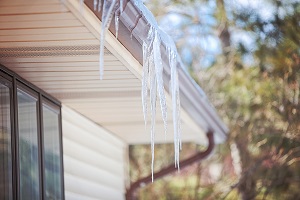
Winter Weather Precautions for Homeowners: 12 Strategies to Battle Ice Dams Icicles hanging off the rooftops always make for a beautiful winter scene.But if those icicles are hanging off your roof, it’s nothing to be taken lightly.Why? Because the very same conditions that formed those icicles are to blame for ice dams.
And that can turn into a costly problem.What are ice dams and what causes them? Ice dams are ridges of ice that form along the eaves of a roof.Heat from the attic warms the roof and melts the snow.
But since there isn’t much heat collecting inside the attic at the edge of the roof, the eaves are much colder.So as the melt water runs down, it freezes again at the eaves, builds up, and creates an ice dam.Four basic factors can cause ice dams to form: Heat from the attic.
Too little insulation or ventilation in the attic is a common culprit.There are also common areas where warm air can escape into the attic such as poorly insulated outlets, light fixtures, and attic doors.Ideal temperatures.
Temperatures between 30 and 32 are ideal for ice dams.At that temperature, it doesn’t take much heat from inside a home to push the temperature on the roof above the freezing mark and begin the melting process.Alternating temperatures.
Even if daytime temperatures are slightly above freezing but fluctuating enough to be well below freezing at night, ice dams can form.As long as thawing can occur during the day, ice dams can form.The sun.
Even when temperatures are below freezing day and night, radiant heat from the sun can continue to melt snow on your roof, contributing to ice dams.What damage can ice dams cause? Once an ice dam gets large enough, melting water can no longer drain into the gutters or onto the ground.Instead, it backs up and can flow under shingles and into the house.
And that can get messy, causing stained and sagging ceilings, peeling paint, warped floors, and soggy insulation in the attic and walls that can collect mold.If the ice dam breaks free, it can even pull shingles and gutters off.What can you do about ice dams? If you already have ice dams, you can try melting a trough through the ice with calcium chloride ice melter in a tube of cloth (such as a leg of pantyhose) laid over the ice dam.
Just don’t go hacking at your ice dams with a hammer, chisel, or shovel.You can seriously damage your roof and injure yourself.Obviously, it’s better to prevent ice dams from forming in the first place.
Here are a dozen strategies to consider: Keep snow removed from your roof using a snow rake, broom, or plastic shovel.Replace your shingle roof with standing seam or other metal roof.Replace the bottom three feet of your shingle roof with a wide metal drip edge.
Seal every point where warm air can leak from the living space into the attic.Properly insulate your living space to prevent conduction and convection of heat through the ceiling.Make sure you have proper ridge and soffit vents to circulate cold air under the roof.
Seal attic hatches with appropriate weather stripping.Ensure all ducts connected to the kitchen, bathroom, and dryer vents lead outdoors through either the roof or walls, never through the soffit.Add more insulation to your attic floor.
Replace older recessed lights that give off heat with sealed “IC” fixtures.Apply fiber-reinforced sealant on the joints of HVAC and exhaust ducts.Turn down your thermostat, which will reduce the heat getting to the attic.
It’s also a good idea to have a home energy audit to uncover your home’s unique problem areas.With that information, you can plan your strategy to keep ice dams from becoming a costly headache.Need more winter tips to protect your home? Talk to the personal insurance professionals at BNC Agency today.
Publisher: Normal for Business








